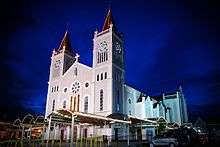Baguio Cathedral
| Baguio Cathedral | |
|---|---|
| Our Lady of Atonement Cathedral | |
 Facade of the Baguio Cathedral in Baguio City, Benguet | |
.svg.png) Baguio Cathedral Republic of the Philippines | |
| 16°24′46″N 120°35′54″E / 16.412744°N 120.598435°ECoordinates: 16°24′46″N 120°35′54″E / 16.412744°N 120.598435°E | |
| Location | Baguio |
| Country | Philippines |
| Denomination | Roman Catholic |
| History | |
| Dedication | Our Lady of Atonement |
| Architecture | |
| Status | Cathedral |
| Functional status | Active |
| Architectural type | Church building |
| Style | Neo-Gothic |
| Groundbreaking | 1920 |
| Completed | 1936 |
| Specifications | |
| Materials | Gravel, Cement, Steel, Concrete |
| Administration | |
| Archdiocese | Roman Catholic Archdiocese of Nueva Segovia |
| Diocese | Roman Catholic Diocese of Baguio |
| Clergy | |
| Archbishop | Marlo Mendoza Peralta |
| Bishop(s) | Carlito J. Cenzon |
Our Lady of the Atonement Cathedral, better known as Baguio Cathedral, is a Roman Catholic cathedral located at Cathedral Loop adjacent to Session Road in Baguio, the Philippines, and is the see of the Roman Catholic Diocese of Baguio. Dedicated to the Blessed Virgin Mary under the title of Our Lady of Atonement, its distinctive pink exterior, twin spires and stained glass windows make it a popular tourist attraction in Baguio.[1] It served as an evacuation centre under the Japanese Occupation during Second World War.
The current parish priest is Bishop Carlito Cenzon.[2]
History
The site where the cathedral currently stands was a hill referred to as Kampo by the Ibaloi people. In 1907, a Catholic mission was established at the site by Belgian missionaries from the Congregatio Immaculati Cordis Mariae, which they later called Mount Mary.
Construction of the cathedral itself began in 1920 under the leadership of the parish priest, Rev Florimond Carlu. The building was completed and consecrated in 1936, receiving dedication to Our Lady of Atonement.
During the Second World War, the cathedral was an evacuation centre, and it withstood the carpet-bombing of Baguio by Allied forces during liberation on 15 March 1945. The remains of the thousands that had died in the bombardment are interred within the cathedral precinct.[3]
Features
The cathedral has a distinctive pink façade with a rose window and twin square belfries with pyramidal roofs.[3] Within its large courtyard is a viewing deck that overlooks Session Road and the downtown commercial district of Baguio. The cathedral is accessible to pedestrians from Session Road via 100-step stone staircase that ends at a Calvary, or through the adjacent campus of Saint Louis University.[4]
Website
The official website will stand as a source of information to catholic faithful all over the world and tourist guide and inquiry for those who are planning to have their weddings, baptisms and other services provided by the church. Schedules, latest news, announcements, marriage banns, and guidelines are provided as well for easier and more helpful visiting.
The website was launched on 30 November 2014 and was developed by Acey Rosete.[5]
See also
Gallery
-

Looking northwest down the nave towards the sanctuary
-

An aerial view of the cathedral
-
A view of the façade at daytime
-

The cathedral from the stairs with the large Calvary at the terminus of the stone stairs.
-

Memorial plaque to the carpet bombing victims buried in the cathedral grounds.
Notes
- ↑ "Baguio Catholic Cathedral". Landmarks and Scenic Sites: The City of Baguio. Archived from the original on 11 April 2008. Retrieved 2008-04-19.
- ↑ "Assigned Parish Priests".
- 1 2 Layug, p. 76
- ↑ Layug, p. 77
- ↑ "Official Website".
External links
| Wikimedia Commons has media related to Baguio Cathedral. |
References
- Layug, Benjamin Locsin (2007). A Tourist Guide to Notable Philippine Churches. Pasig City, Philippines: New Day Publishers. pp. 76–77. ISBN 971-8521-10-0.
